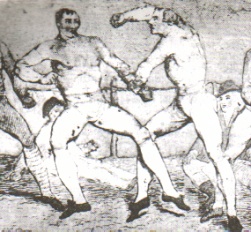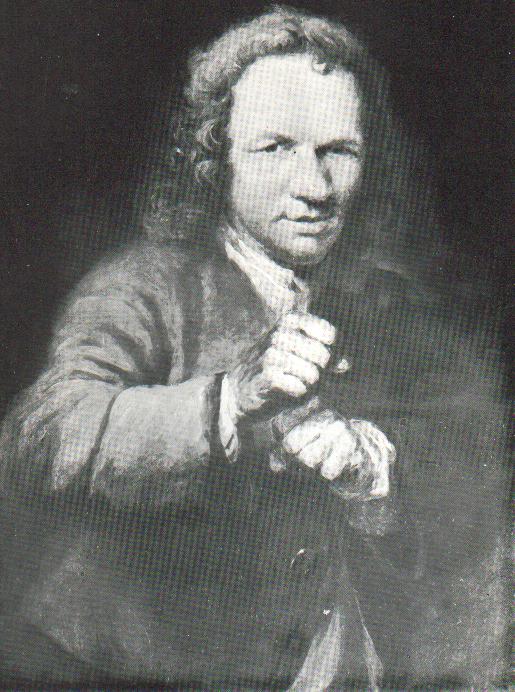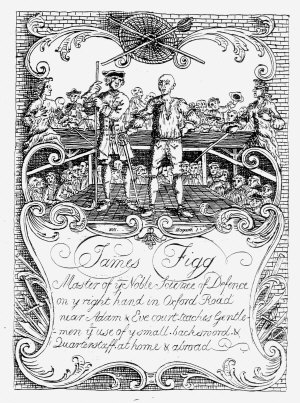The original art of Western Boxing was once a complete armed & unarmed martial art system, which included a wide
range of weaponry and covered kicking, punching & grappling. During the late 17th to mid 18th centuries "prizefighters"
would fight against all comers for prizes of money, free beer, hats or cups. Other gladiatorial showmen fought to test the
skills of a rival teacher or his students or for some real or imaginary slight. These were no-holds-barred contests which
would usually take place over three bouts, one of swordplay with a choice of live swords, daggers & shields, one of boxing,
and one of quarterstaff or cudgels. The earliest "boxers" not only had to learn various weapon skills they also trained in
a fist fighting art that included eye gouging, hair pulling, head-butting, low sweeping shin-kicks, wrestling throws and grappling
whilst on the ground.
In 1637 a collection of poems celebrating "Mr Robert Dovers Olimpic Games upon Cotswold-Hills"
stated that: "The warrelike Champion with his powerful fists, Contended for the Prize, as in our lists" These Cotswold Olympics
also held regular Shin-Kicking events.
In June 1663 Samual Pepys recorded in his diary "the first prize I ever saw
in my life" which was held in the New Theatre, a former tennis court. It was between Matthews and one Westwicke, "who was
soundly cut several times in the head and legs that he was all over with blood; and other deadly blows did they give and take
in very good earnest, till Westwicke was in a most sad pickle" They fought using eight weapons, three bouts at each weapon.
In
April 1667 in the London Bear Garden he saw a prize fought between a soldier and a country fellow called, Warrell, "who did
soundly beat the soldier and cut him over the head." Pepys wrote in May 1667 of a match in the Bear Garden, between a butcher
and a waterman. During the fight the waterman dropped his weapon and was immediately cut on the wrist so that he was unable
to continue. He later witnessed another match between a shoemaker and a butcher, as in the last fight the shoemaker was "so
cut on the wrists that he could fight no longer, and then they broke off.
The "Protestant Mercury" January 1681 carried
the first newspaper report of a bare knuckle bout between the Duke of Albermarle's Footman and a Butcher, which the latter
is said to have won.
In July 1700 John Terrewest fought Thomas Hesgate at the Bear Garden with rounds of back-sword,
sword & Dagger, sword & buckler, sword and gauntlet, single falchon, and case of falchons. Terrewest received one
wound but Hesgate 5 or 6 so he lost the day. Another fight took place that day between a Davis and one Gorman. In the first
round Davis was wounded in the throat, he continued into the second round where he wounded Gorman in the side but was struck
with a heavy blow to the forehead and passed out, unable to continue into the third round.
In 1711 an article in the
London Spectator mentioned "a ring of cudgel-players, who were breaking one another"s heads in order to make some impression
on their mistresses' hearts." This cudgel-play was followed by a football game and a wrestling match.
Sometime between
1713 and 1715 Scottish soldier, Donald McBane on returning home from the wars on the continent, turned to keeping an ale house
and a fencing school in London, where he fought thirty seven Prizes in the Bear Garden.
On the 23rd June 1726 at the
Abbey of Holyrood House, Edinburgh, upon a public stage, McBane (aged 63) fought the Irish Gladiator, Andrew O'Bryen before
a large crowd. He gave him seven wounds and broke his arm with the Fauchion. (a short broadsword curved sharply to a point)
The Edinburgh Evening Courant (June 1726) reported that "Old Donald Bane, alias McBane, from the north of Scotland, quite
defeat the Irishman, and almost cut him to pieces, and shamefully beat him off the stage, for challenging the whole country"
According
to a 1714 London newspaper account, James Figg, now considered as the Father of Boxing, was in London working under one Timothy
Buck of Clare Market. The Earl of Peterborough is said to have set up Figg with premises on the Oxford Road where he taught
pugilism, small backsword and quarter-staff, he was so successful he later moved to the Adam and Eve. Between 1718-1719, Figg
had defeated 15 unnamed opponents.
In 1722 an Elizabeth Wilkinson challenged Hannah Hyfield to meet her on stage, and
box for a prize of three guineas. The rules required each woman to strike each other in the face while holding a half-crown
coin in each fist, the first to drop a coin would be the loser. According to the London Journal, the two women "maintained
the Battle with great Valour for a long Time, to the no small Satisfaction of the Spectators."
In 1723 King George
I ordered the construction of a ring encircled by railings in Hyde Park to be used by the public for boxing.
In 1725
a newspaper reported a fighter from Italy, "famous for boxing and victories that way" was visiting London, this led to what
may have been the first international challenge match at Figg's School of Arms on Oxford Street. The fight between Venetian
gondolier Stopa l'Acqua against John Whitacker of London, resulted in an English victory.
In August 1725 Figg and a
woman called Long Meg of Westminster fought Ned Sutton and an unnamed woman; Figg and Meg won the prize of £40.
In
October of 1726 at Mr Stokes's Amphitheatre in London, Elizabeth Stokes, championess of England accepted a challenge from
the Irish female champion Mary Welch, to "exercise the usual weapons practis'd on the stage"
In January 1727, a Hugh
MacDonald challenged Ned Sutton, "the Invincible Kentish Champion" using the "usual weapons practis'd on the stage" Sutton
claimed that MacDonald, the Hibernian tanner, was calling himself the only master of the staff in Europe so they would begin
the fight with the staff.
On the 6th of June 1727, Figg fought the Gravesend pipe-maker, Ned Sutton. The first round
was with swords and a cut to Sutton's shoulder resulted in Figg winning that round. The second round was fist-fighting which
included throws and grappling, Figg won this round by submission. The third round was with cudgels during which Figg shattered
Sutton's knee to win the match.
The gladiatorial showmen and women of Britain and Ireland trained with the same dedication
as their eastern counterparts, developing a wide variety of armed & unarmed skills, and a high degree of physical endurance.
But over time, as fights became more commercialised and rules introduced, grappling, kicks and the use of weapons were gradually
phased out, resulting in the separate systems of boxing, wrestling and fencing we see today.
|
 |
|
|
|
 |
Billy Marshall - Scotland's first noted pugilist champion
Billy Marshall (1672-1792) was born in Ayrshire, was said to be or Romany stock and is described as the King
of the Gypsies in south-east Scotland for most of the 1700s. His career included time as a boxer, and in the services. The
stories about him are that he deserted from the Army seven times and from the Navy three times, he married 17 times and he
had a huge crowd of illegitimate children (four of whom he is said to have fathered after his 100th birthday). He is also
said to have been involved in murder and robbery, running a gang of gypsy tinkers in Galloway. He was the so-called 'King
of the Randies', and having served as a soldier he was able to organise the country people who lost land when landowners built
stone dykes and walls - his men went round knocking them down.
Marshall died at the age of 120 and his grave is in
the churchyard of St Cuthbert's in Kirkcudbright.






|
 |
|
|
|

